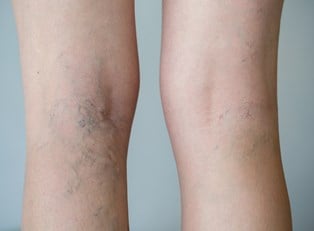If you have spider veins, you have likely encountered some new, unfamiliar terms while researching your condition and seeking treatment. It is important to understand the vocabulary associated with spider veins, especially words that you will hear often. Here are the 10 terms that every person with spider veins needs to know.
- Varicose Veins
Many people think that varicose veins and spider veins are the same thing. While people with spider veins may develop varicose veins as well, there are several key differences. Spider veins are small and thin, while varicose veins are thick and ropy. Spider veins usually pose no health threat (except the possibility of developing varicose veins), but varicose veins are a serious medical issue. - Telangiestasias
This long and complicated word is simply the medical term for spider veins. - Circulation
Circulation is the movement of blood, lymph, and other fluids throughout the body. Spider veins are sometimes an indication that there are issues with the body's circulation, which can be treated with exercise, elevation of the affected limbs, and compression stockings. - Valve
As blood is carried away from your extremities by veins, a series of valves ensures that the blood is moved quickly without pooling or moving back into the extremities. Spider veins may be a sign that these valves are leaky or not working correctly, which is sometimes called valvular insufficiency. - Ultrasound
Ultrasound is often used to diagnose spider veins and varicose veins. It is a radiation-free imaging method that can show the state of veins and blood flow in a region. - Ablation
This is the most common treatment used for spider veins. A laser, radiofrequency, or other form of energy is used to destroy spider veins without damaging other tissues. - Sclerotherapy
Sclerotherapy is the preferred treatment when ablation and lifestyle measures have not successfully treated spider veins. In this treatment, a substance is injected into the problem veins that irritates the vein's lining and causes it to turn to a scar. Blood is naturally diverted by the body to other, healthier veins. Sclerotherapy is very effective but more invasive than ablation. - Compression Stockings
These stockings are very tight and are made of a strong elastic or other similar material. Some people with spider veins wear them to increase pressure on the veins, which reduces discoloration, swelling, and and other symptoms. - Vascular Surgeon
This is a type of doctor that treats spider veins with sclerotherapy and surgery. In addition, plastic surgeons, general surgeons, and dermatologists offer ablation and other therapies that reduce the appearance and side effects of spider veins. - Thrombophlebitis
This is when an area with spider veins or varicose veins develops a clot and becomes inflamed. Redness, pain, and itching are the initial symptoms. Thrombophlebitis can be a complication of untreated spider veins or, more commonly, varicose veins. It's important to call a doctor or seek medical care if the symptoms of thrombophlebitis occur.



